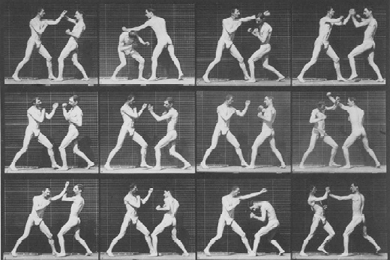By Roslyn Kramer
The energy of an inventive America around the turn of the century bounces off the surfaces of paintings and film at the latest exhibit at New York University’s Grey Gallery, “Moving Pictures: American Art and Early Film, 1880- 1910.” Funny, sentimental, awesome and awkward, the exhibit hits the high points of American culture when fine art and the popular art of moviemaking intersected — a connection that is generally unrecognized. This exhibit is intended to fill the vacuum, or in the catalog’s introductory words, it “attempts nothing less than rewriting our standard histories of this period.”
The first moving picture was by Eadweard Muybridge, an Englishman who put so many sequential images of a moving horse on a round, rigid disk (flexible rolls of film were about a decade away) that every movement culminating in a gallop was visible. The outcome was the disconcerting discovery that painters were getting a galloping horse all wrong — the animal moved faster than the human eye, but its movements could be caught by the camera’s lens.
“Muybridge got worldwide attention; he showed how to use photography to see the unseen,” says Nancy Mowll Mathews, curator of the exhibit, which ends Dec. 9th.
As celebrated as Muybridge was, his deconstruction of a moving horse was not universally admired. When the prominent artist Thomas Eakins applied this revolutionary discovery of a horse’s movements in a charming painting, “A May Morning In the Park,” one critic felt the result was not aesthetic enough. And not all artists adopted Muybridge’s discovery. Frederic Remington, for example, painted horses that did not always gallop realistically. But realism was becoming the cutting edge of art, and many embraced it.
Eventually the indefatigable Muybridge moved beyond horses, incorporating dancers, boxers, men and women clothed and unclothed in his studies, sometimes hauling his mammoth camera up mountains. (The British-born photographer was so captivated by the American West, he sported a ten-gallon hat and western attire, a look popularized by rough-riders Theodore Roosevelt and Buffalo Bill Cody, even when he was abroad.)
Mary Cassatt adopted the concept of Muybridge’s sequential images in her paintings of mothers and children. Her domestic theme was also timely; Americans, in film as in art, were captivated by everyday reality, whether it was the tender informality of Cassatt’s mothers and children in art or the honest labor of blacksmiths at work or the roiling waters of “Rough Sea at Dover” in film. As “Moving Pictures” makes clear, turn of the century painters were just as fascinated by motion as early filmmakers.
In 1896 two theater actors trekked out to Thomas Edison’s New Jersey studio to commit a brief but climactic moment from their musical comedy to film. Although the “May Irwin Kiss” — included in the exhibit — is less than steamy, it was the most popular film of the year.
Perhaps more sensual than the kiss sequence were Edison’s films of female entertainers dancing, sometimes in diaphanous, full-skirted costumes. Compared to his biggest competition — the French Lumiere family and its emphasis on hearth, home and the outdoors — Edison’s professional performers seemed cosmopolitan, independent and were filmed indoors.
Says Yale film scholar Charles Musser, “The Lumieres celebrated family and above all their happy, bourgeois family. American female entertainers, on the other hand, made their own living,” says Musser. “They were free agents; elusive and independent.”
Watching a moving picture at that time required peering into a waist-high box at a small image. But in 1896, another massive change occurred: projection. With a new machine, the Vitascope, motion pictures could be projected onto a screen. Not only was this economical — now many more people could watch moving pictures — the lifelike-size awed viewers. Speeding trains heading into the camera made people flinch; pounding water in waves or waterfalls fascinated audiences. And to underline the importance of what one was seeing, a gold picture frame bordered the screen, suggesting a certain artistic grandeur that earlier moving pictures lacked.
The intersection between painting and moving pictures occurred among practitioners, too. Maurice Prendergast, a colorful painter of lively urbanites at play, “was also a pop culture hound,” says Mathews. “He owned stock in a film company.” And though Edison was not trained in the arts, members of his team were. “They were not just technicians,” Mathews asserts. “These artists were borrowing composition among other things, from fine arts.” One great film innovator, J. Stuart Blackton, couldn’t make a living as a marine painter, but instead worked for a newspaper and eventually owned a film company, which became the most important in New York. Moving pictures of him sketching Edison are also on exhibit.
Although the connection between fine art and moving pictures seems sometimes difficult to grasp, the show is a gas, recalling the wonder the first movie audiences felt and a good-humored energy not usually associated with the turn of the century.






































